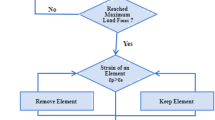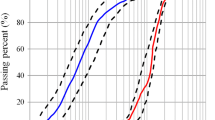Abstract
The aim of this paper is to investigate the microstructure indicators and more effective durability mechanisms of SCCs (Self-Consolidating Concretes) containing supplementary cementitious material. The reference SCC mixture at constant water-to-cementitious material (W/CM) ratio of 0.45 and total cementitious material content of 450 kg/m3 was prepared. The other mixes containing binary (92% PC + 8% SF, 88% PC + 12% SF, and 80%PC + 20%MK) and ternary (72%PC + 8%SF + 20%MK) cementitious blends of metakaolin and silica fume were studied. The effect of using MK and SF in SCCs made with binary and ternary cementitious blends of metakaolin and silica fume and cement on chloride transport and electrical properties was investigated by measuring electrical resistivity parameters such as pore surface conductivity, pore solution conductivity, and tortuosity of pores as chemical and physical indicators of durability. Observations indicated a stronger relationship between the chloride migration coefficient and pore surface conductivity. A new parameter τσ s (multiplication of tortuosity and pore surface conductivity), called pore chemi-physical factor, was introduced. Results indicate that the addition of pozzolanic materials such as silica fume and metakaolin leads to a remarkable increase in pore surface conductivity. The correlation coefficient between τσ s and the chloride migration coefficient was 0.97. So, if chloride ions are absorbed by pore surfaces, the chloride migration coefficient will decrease in greater tortuosity.








Similar content being viewed by others
References
Sugiyama T, Ritthichauy W, Tsuji Y (2008) Experimental investigation and numerical modeling of chloride penetration and calcium dissolution in saturated concrete. Cem Concr Res 38(1):49–67
Sugiyama T, Ritthichauy W, Tsuji Y (2003) Simultaneous transport of chloride and calcium ions in hydrated cement systems. J Adv Concr Technol 1(2):127–138
Maltais Y, Samson E, and Marchand J, (2004) Predicting the durability of Portland cement systems in aggressive environments—Laboratory validation. Cem Concr Res, 34(9):1579–1589.
Stanish K, Hooton RD, Thomas MDA (2004) A novel method for describing chloride ion transport due to an electrical gradient in concrete: part 1. theoretical description. Cem Concr Res 34(1):43–49
Glass GK, Buenfeld NR (2000) The influence of chloride binding on the chloride induced corrosion risk in reinforced concrete. Corros Sci 42(2):329–344
Neithalath N, Jain J (2010) Relating rapid chloride transport parameters of concretes to microstructural features extracted from electrical impedance. Cem Concr Res 40(7):1041–1051
Tsivilis S, Tsantilas J, Kakali G, Chaniotakis E, and Sakellariou A, (2003)The permeability of Portland limestone cement concrete. Cem Concr Res, 33(9):1465–1471.
Igarashi S, Watanabe A, Kawamura M (2005) Evaluation of capillary pore size characteristics in high-strength concrete at early ages. Cem Concr Res 35(3):513–519
Cam HT, Neithalath N (2010) Moisture and ionic transport in concretes containing coarse limestone powder. Cem Concr Compos 32(7):486–496
Neithalath N, Persun J, Hossain A (2009) Hydration in high-performance cementitious systems containing vitreous calcium aluminosilicate or silica fume. Cem Concr Res 39(6):473–481
Grathwohl P Diffusion in natural porous media: contaminant transport, sorption/desorption and dissolution kinetics. Springer US, 2012
Glass GK, Buenfeld NR (2000) Chloride-induced corrosion of steel in concrete. Prog Struct Eng Mater 2(4):448–458
Luping T, Nilsson L-O (Mar. 1993) Chloride binding capacity and binding isotherms of OPC pastes and mortars. Cem Concr Res 23(2):247–253
Zibara H, Hooton RD, Thomas MDA, Stanish K (2008) Influence of the C/S and C/A ratios of hydration products on the chloride ion binding capacity of lime-SF and lime-MK mixtures. Cem Concr Res 38(3):422–426
Yuan Q, Shi C, De Schutter G, Audenaert K, Deng D (2009) Chloride binding of cement-based materials subjected to external chloride environment—a review. Constr Build Mater 23(1):1–13
Friedmann H, Amiri O, Aı̈t-Mokhtar A, Dumargue P (2004) A direct method for determining chloride diffusion coefficient by using migration test. Cem Concr Res 34(11):1967–1973
Chatterji S, Kawamura M (1992) A critical reappraisal of ion diffusion through cement based materials. Part 1: sample preparation, measurement technique and interpretation of results. Cem Concr Res 22(4):525–530
Nguyen PT, Amiri O (2014) Study of electrical double layer effect on chloride transport in unsaturated concrete. Constr Build Mater 50:492–498
Rajabipour F, Weiss J (Dec. 2007) Electrical conductivity of drying cement paste. Mater Struct 40(10):1143–1160
Kapoor K, Singh SP, and Singh B, (2016) Water permeation properties of self compacting concrete made with coarse and fine recycled concrete aggregates, Int J Civ Eng, 1–10, doi:10.1007/s40999-016-0062-x
Meesaraganda LV, Saha P, and Laskar AI, (2016) Behaviour of self-compacting reinforced concrete beams strengthened with hybrid fiber under static and cyclic loading, Int J Civ Eng, 1–10, doi:10.1007/s40999-016-0114-2
Ziari H, Hayati P, and Sobhani J, (2016) Air-entrained air field self-consolidating concrete pavements: strength and durability, Int J Civ Eng, 1–13, doi:10.1007/s40999-016-0104-4.
Sarıdemir M, Severcan MH, Çiflikli M, and Çelikten S, (2016) Microstructural analyses of high strength concretes containing metakaolin at high temperatures. Int J Civ Eng, 1–13, doi:10.1007/s40999-016-0081-7.
Swamy RN, Cement Replacement Materials. Surrey University Press, 1986
Karahan O, Hossain KMA, Ozbay E, Lachemi M, Sancak E (Jun. 2012) “Effect of metakaolin content on the properties self-consolidating lightweight concrete”. Constr Build Mater 31:320–325
Lachemi M, Bae S, Hossain KMA, Sahmaran M (Oct. 2009) Steel–concrete bond strength of lightweight self-consolidating concrete. Mater Struct 42(7):1015–1023
Güneyisi E, Gesoğlu M, Karaoğlu S, and Mermerdaş K, (2012)Strength, permeability and shrinkage cracking of silica fume and metakaolin concretes. Constr. Build. Mater., 34:120–130
Nanthagopalan P, Santhanam M (Mar. 2011) Fresh and hardened properties of self-compacting concrete produced with manufactured sand. Cem Concr Compos 33(3):353–358
Fernandez R, Martirena F, Scrivener KL (Jan. 2011) The origin of the pozzolanic activity of calcined clay minerals: A comparison between kaolinite, illite and montmorillonite. Cem Concr Res 41(1):113–122
Coleman NJ, Mcwhinnie WR (2000) The solid state chemistry of metakaolin-blended ordinary Portland cement. J Mater Sci 35(11):2701–2710
Torquato S Random heterogeneous materials: microstructure and macroscopic properties. Springer Science & Business Media, 2013
Garboczi EJ (Jul. 1990) Permeability, diffusivity, and microstructural parameters: a critical review. Cem Concr Res 20(4):591–601
Herrick DC, Kennedy WD (Jun. 1994) Electrical efficiency—A pore geometric theory for interpreting the electrical properties of reservoir rocks. Geophysics 59(6):918–927
European Federation for Specialist Construction Chemicals and Concrete Systems, “EFNARC, Guidelines for self-compacting concrete.” p. 32, 2002.
Yajun J, Cahyadi JH (Oct. 2003) Effects of densified silica fume on microstructure and compressive strength of blended cement pastes. Cem Concr Res 33(10):1543–1548
Bach TTH, (2010) Evolution physico-chimique des liants bas pH hydrates. Influence de la temperature et mécanisme de retention des alcalins, Université de Bourgogne, Dijon, France
Lothenbach B, Scrivener K, Hooton RD (Dec. 2011) Supplementary cementitious materials. Cem Concr Res 41(12):1244–1256
Thomas MDA, Hooton RD, Scott A, Zibara H (Jan. 2012) The effect of supplementary cementitious materials on chloride binding in hardened cement paste. Cem Concr Res 42(1):1–7
Dousti A, Shekarchi M, Alizadeh R, Taheri-Motlagh A (Nov. 2011) Binding of externally supplied chlorides in micro silica concrete under field exposure conditions. Cem Concr Compos 33(10):1071–1079
Roberts MH (1962) Effect of calcium chloride on the durability of pre-tensioned wire in prestressed concrete. Mag Concr Res 14(42):143–154
Author information
Authors and Affiliations
Corresponding author
Rights and permissions
About this article
Cite this article
Ghoddousi, P., Adelzade Saadabadi, L. Pore Structure Indicators of Chloride Transport in Metakaolin and Silica Fume Self-Compacting Concrete. Int J Civ Eng 16, 583–592 (2018). https://doi.org/10.1007/s40999-017-0164-0
Received:
Revised:
Accepted:
Published:
Issue Date:
DOI: https://doi.org/10.1007/s40999-017-0164-0




